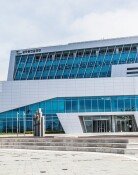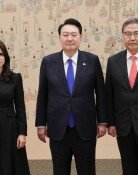Air Force Operational Command
The Air Forces Master Control and Reporting Center (MCRC) has a giant screen showing the territories of the Korean Peninsula, Japan, eastern China and Russian Far East. All air traffic tracks screened by radar of the South Korean Air Force installed nationwide are displayed on the screen. The MCRC also displays information on flights of other countries. China, North Korea, Japan and Russia do not provide aviation information on military aircraft to the center, however. Tracks of those flights are considered unidentified. Staff at the center pay extra attention to unidentified tracks in the North Korean region.
The MCRC moves in tandem with the Theater Air Control Center (TACC). The Air Force defines a tactical action line and extended the line further out. If an unidentified air track crosses the extended tactical action line, the TACC orders a nearly military airbase to be on combat standby. Then pilots on emergency standby board fighter jets immediately. If unidentified air tracks cross the tactical action line, the TACC orders the airbase to deploy flights and inform the commander of the Air Force Command, who in turn determines whether to intercept. So the commander should always remain vigilant around the clock.
Since aircraft move at extremely high speeds, a single command generally controls modern air combat. In the Iraq War in 2003, the U.S. Air Forces Central Command commanded U.S. Air Force and British naval aircraft on an aircraft carrier and the air force aircraft of other allied forces. Even after the wartime operational command is returned to the South Korean military, in case of war, South Korea and the U.S. will form an Air Force Joint Military Command to be headed by the U.S. 7th Air Force commander and the South Korean Air Force Operational Command as vice commander. This joint command will collectively direct South Korea and U.S. military aircraft and U.S. naval aircraft. Likewise, Air Force operations are most efficient when conducted professionally by one person.
Air Force Chief of Staff Park Jong-heon said, The proposed military reform that involves the Air Force chief of staff to double as chief of the Air Force Operational Command is problematic. He thus indicated that it is impossible for the Air Force chief of staff, who must oversee various fields including personnel affairs and budget, to solely focus on operations. The Defense Ministry has not shown clear response, however. Park visited the ministrys media room Sunday and said in a briefing, My remarks were exaggerated in news reports. It is worrisome whether the proposed defense reform will proceed smoothly since different people have conflicting opinions.
Editorial Writer Lee Jeong-hoon (hoon@donga.com)
Headline News
- N. Korea launches cyberattacks on S. Korea's defense companies
- Major university hospital professors consider a day off each week
- Italy suffers from fiscal deficits from ‘Super Bonus’ scheme
- Inter Milan secures 20th Serie A title, surpassing AC Milan
- Ruling and opposition prioritize spending amid tax revenue shortfalls







